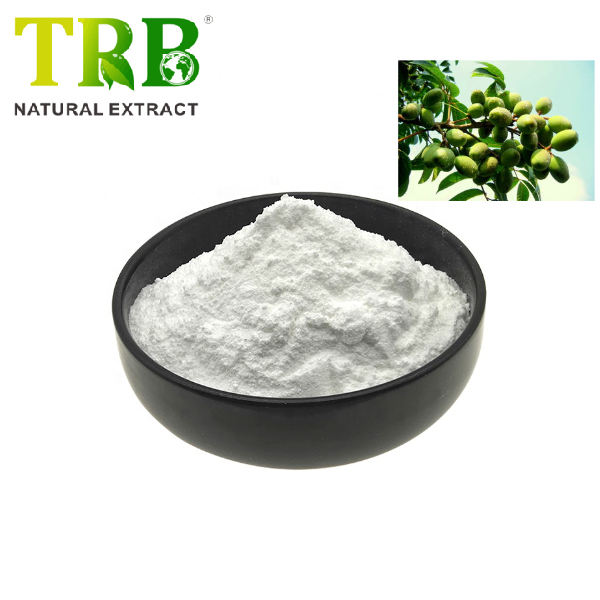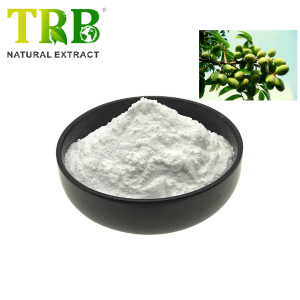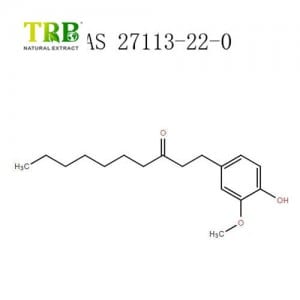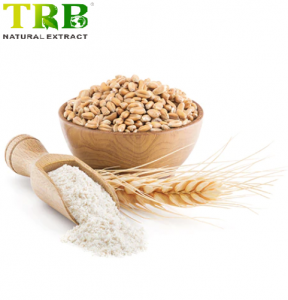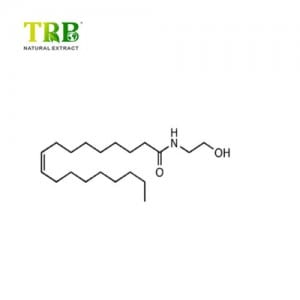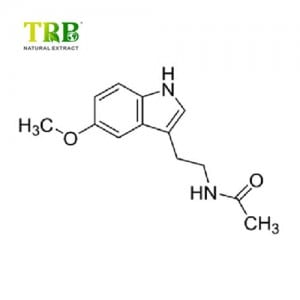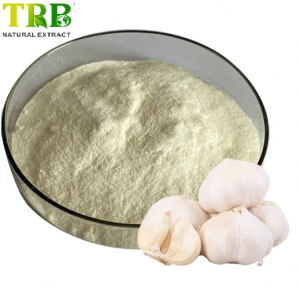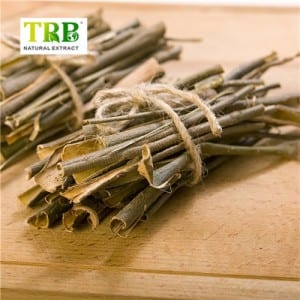Oleanolic acid he ʻekolu pentacyclic triterpenoids i hoʻokaʻawale ʻia mai nā mea kanu Gentianaceae o Swertia mileensis ka mauʻu a i ʻole nā hua privet, me ke kino manuahi a me nā glycosides i nā mea kanu he nui.ʻO ka waika Oleanolic he ākea ākea i nā mea kanu, a ʻo ka ʻike maʻamau he 0.2% - 2%.ʻO Cucurbitaceae maʻiʻo kiʻekiʻe he 1.5% ~ hunchback lalo 2%, privet hua maʻiʻo o 0.6% ~ 0.7%. Oleanolic acid he ʻano pentacyclic triterpenoid pūhui i hoʻokaʻawale ʻia mai ka hua o ka genus Asteraceae, Syzygium sylvestris, a i ʻole Ligustrum lucidum.He adjuvant maʻi ate a hoʻohana ʻia no ka maʻi therapeutic.ʻO ka maʻi hepatitis acute ka hopena i ka hoʻohaʻahaʻa ʻana i ka alanine aminotransferase a me ka melemele. ʻO ka waika Oolic kahi triterpenoids pentacyclic i hoʻokaʻawale ʻia mai ka hua o swertia chinensis a i ʻole fructus ligustris mai ka mea kanu gentianaceae.Loaʻa ka ʻakika Oleanolic i nā mea kanu, me kahi maʻi maʻamau o 0.2% ~ 2% [1].ʻO ka maʻiʻo o lalo o ka ipu he 1.5% ~ 2%, a ʻo ka maʻi o ka hua o ka fructus ligustris he 0.6% ~ 0.7%.ʻO ka ʻakika Oleanolic he aniani acicular keʻokeʻo (ethanol), ʻaʻala ʻole a ʻono ʻole.Paʻa ʻole i nā ʻakika a me nā kumu.Ka helu hehee o 308 ~ 310 ℃, [alpha] 20 d + 73.3 ° (c = 0.15, chloroform, hiki ole ke hooheheeia i ka wai, hiki ke hooheheeia i ka methanol, ethanol, ethyl ether, acetone a me ka chloroform. Oleanolic acid he triterpenoid maoli, laha nui ia. i nā meaʻai a me nā lāʻau lapaʻau, pili i ka waikawa betulinic Hiki ke loaʻa iā Phytolacca americana (American pokeweed), a me Syzygium spp, garlic, etc.
Ua ʻike ʻia ka ʻakika Oleanolic e hōʻike i ka hana anti-HIV ikaika, ua hoʻohana ʻia ka hui pūhui betulinic acid e hana i ka lāʻau lapaʻau mua ʻoihana maturation inhibitor.Ua aʻo mua ʻia a hoʻokaʻawale ʻia mai kekahi mau mea kanu, e like me Rosa woodsii (lau), Prosopis glandulosa (lau a me nā lālā), Phordendron juniperinum (mea kanu holoʻokoʻa), Syzygium claviflorum (lau), Hyptis capitata (mea kanu holoʻokoʻa), a me Ternstromia gymnanthera (aerial). hapa).ʻO nā ʻano ʻano Syzygium ʻē aʻe e pili ana i ka ʻāpala java (Syzygium samarangense) a me nā ʻōlaʻi rose.
Ka inoa huahana: Oleanolic Acid98%
Hōʻike: 98% na HPLC
Puna Botanic: Olea Europea Extract
Inoa Kemika:(3β)-3-Hydroxyolean-12-en-28-oic acid
ʻAʻohe CAS:508-02-1
Māhele i hoʻohana ʻia:Leaf
Kala: ʻO ka pauka keʻokeʻo me ka ʻala a me ka ʻono
Kūlana GMO: ʻAʻole GMO
Hoʻopili: ma 25kgs fiber drums
Ka mālama ʻana: E mālama i ka pahu i wehe ʻole ʻia ma kahi maloʻo a maloʻo, e haʻalele i ka mālamalama ikaika
Ola Ola: 24 mahina mai ka lā i hana ʻia
He ahaoleanolic acid?
Oleanolic acid (OA), he hydroxyl pentacyclic triterpenoid acid maoli (HPTA) like me ka betulinic acid, ursolic acid;Loaʻa iā ia nā pono e like me antibacterial, anti-inflammatory, antitumor activities.

Ma hea ʻoe e loaʻa aioleanolic acid?
Ua hoʻohana maʻamau ʻo Oleanolic acid no ka mālama ʻana i nā maʻi like ʻole, hiki iā ʻoe ke loaʻa i ka meaʻai a me nā mea kanu ākea.
ʻO kekahi mau huaʻai e like me ka ʻāpala, ka pomegerane, ka lemona, ka bilberries, nā ʻoliva i loaʻa pū kekahi oleanolic acid.

| Inoa Laau | ʻO ka waika Oleanolic | ʻano hoʻāʻo |
| Ligustrum lucidum Ait | 0.8028% | HPLC |
| ʻO Verbena Officinalis L | 0.071%-0.086% | HPLC |
| ʻO Prunella vulgaris L | 3.47%-4.46% | HPLC |
| Hemsley Chinensis Cogn. | 1.5%~2% | HPLC |
I kēia manawa, lāʻau lapaʻau KinaHemsley Chinensis Cognʻo ia ka mea kūʻai nui loa no ka unuhi ʻana i ka waika oleanolic.
Hemsley Chinensis Cogn.Hoʻolauna
Hemsleya chinensis Cogn.he laʻau piʻi mau, he lāʻau lapaʻau Kina.
ʻohana: Cucurbitaceae
Tribus: Gomphogyneae
ʻAno: Hemsleya
ʻAnoʻano: H. amabilis
Hāʻawi ʻia ka lau nahele ma nā panalāʻau ʻo Guangxi, Sichuan, Guizhou, Yunnan, Hubei, a me nā mea ʻē aʻe. Hānau ʻia ma ka lihi o ka ululāʻau a me nā kumu lāʻau awāwa ma kahi kiʻekiʻe o 2,000 mika.
ʻO nā mea hana: aia ʻo Hemslolide Mal、Ma3、H1;Chikusetusaponin-Iva;dihydro cucurbitacin F-25-acetate;dilydrocucurbitacin F;oleanolic acid-beta-Hlucosyloleanolate;Hemsamabilinin A;Cu-curbitacinⅡb-2-beta-D-glucopyranoside.
Nā Waiwai Lapaʻau:
Hemsleya chinensis Cogn.ʻO ka mea nui no ka detoxification, sterilization, anti-inflammatory, hoʻoikaika i ka ʻōpū a hoʻomaha i ka ʻeha.I kēia manawa, aia nā extracts pauda, a i ʻole nā mea hoʻomākaukau hoʻohui e like me nā capsules, nā papa, nā ʻōpū o ka ʻōpū, a me nā mea ʻē aʻe, i hoʻohana nui ʻia i ka hana lapaʻau.

Unuhi o Oleanolic acid maiHemsleya Chinensis Cogn.

ʻO nā kumu hoʻohālikelike i loaʻa ka waika Oleanolic i nā meaʻai meaʻai
Ua ʻike mākou ʻo ka ʻakika oleanolic i hoʻohana ʻia i nā mea hoʻohui olakino no loko mai o ʻekolu ʻano o nā mea kanu: Loquat leaf extract, Hemsley Chinensis extract, and holy basil extract.
- ʻO ka pauka Basil Hemolele (lau) (0.4% Ursolic acid a me Oleanolic acid, 2.0 mg)
- Holy Basil supercritical CO2 extract (lau) (Ocimum tenuiflorum Linn.) (2.5% Ursolic acid a me Oleanolic acid, 1.5 mg)
- ʻO ka Loquat Extract (hua) (hāʻawi i ka ʻakika Ursolic, Oleanolic Acid) (Hoʻohālikelike ʻia i ka waikawa Ursolic no ka lawelawe ʻana 125mg)

Oleanolic acid VS Ursolic acid
ʻO ka ʻakika Oleanolic (OA) a me ka waikawa ursolic (UA) he triterpenoids maoli i loaʻa ke ʻano kemika like.
ʻIke ʻia kēia mau pūhui triterpenoids i loko o nā lāʻau lapaʻau a me nā meaʻai.
Loaʻa iā lākou nā waiwai pharmacological maʻamau: hepatoprotective, anti-inflammatory, antimicrobial, hypoglycemic, antimutagenic, anti-HIV activity, antioxidant, a me nā hana antifertility.

ʻokoʻa OA a me UA:
| inoa mea kūʻai | Oleanolic acid | ʻAikika Ursolic |
| CAS NO. | 508-02-1 | 77-52-1 |
| Pentacyclic triterpenes | β-Amyrin | α-Amyrin |
| Nā kumu lāʻau | Lau Loquat, Basil Hemolele, Rosemary, lau Olive. etc. | |
| Nā kikoʻī | 40%,98% pauda | 15%,25%,50%,98% pauda |
| Ke ʻano (ka waihoʻoluʻu a me ka ʻala) | 40% melemele māmā98% pauda keʻokeʻo ʻole | 15%-50% ʻeleʻele-melemele a i ʻole melemele98% pauda keʻokeʻo |
| Hoʻokaʻawale | IR:(1355~1392cm-1) ʻelua piko(1245~1330cm-1) ʻekolu pikoNMR:δ(C12)122.1,δ(C13)143.4 | (1355~1392cm-1) ʻekolu piko (1245~1330cm-1) ʻekolu pikoδ(C12)125.5,δ(C13)138.0 |
| Nā huaʻōlelo | Oleanolic sodium saltOleanolic acid phosphate disodium salt3-oxo oleanolic acid bardoxolone methyl (CDDO-Me) | ʻO ka paʻakai sodium Ursolic a me kāna ʻakika dicarboxylic half ester derivativesUrsolic acid ketene derivatives3-carbon ursolic acid 3-acetoxyursolic acid |
| Hiki i ka maʻi maʻi maʻi | Ua kaulana ʻo UA ma mua o OA. | |
Nā Hana Ola o Oleanolic Acid
-
Nā hopena anti-tumour/anti-cancer
Ka hopena pale o ka oleanolic acid ma ka hepatocellular carcinoma ma o ERK-p53-mediated cell cycle hopu a me ka mitochondrial-dependent apoptosis
- na Xin Wang, Hua Bai, etc. Nā mea noiʻi
Ua hōʻike ʻo OA i kahi hopena paʻa i ka HCC ma o ka hoʻokomo ʻana o ka apoptosis a me ka hopu ʻana o ka cell cycle i nā maʻi maʻi transplanted a ma nā pūnaewele HepG2.
Hoʻokomo ʻia ʻo OA i ka apoptosis ma o ke ala mitochondrial, i hōʻike ʻia e ka pale ʻana i ka pahuhopu Akt / mammalian o ke ala rapamycin.
Hoʻokomo ʻia ʻo OA i ka hopu ʻia ʻana o ka pōʻai cell G2/M ma o ka p21-mediated down-regulation o cyclin B1/cdc2.
Ua hōʻike ʻo OA i nā hana antitumor koʻikoʻi i ka HCC ma nā hiʻohiʻona vivo a me in vitro.Hāʻawi kēia mau ʻikepili i ka ʻike hou i nā mīkini i lalo o ka hopena antitumor o OA.
Eia kekahi, ua hōʻike ʻia nā noiʻi ʻo OA a me kāna derivative Oleanolic acid methyl ester i nā hopena i ka maʻi kanesa o ka umauma, ka maʻi ʻāʻī, ka maʻi maʻi maʻi maʻi, ka maʻi maʻi cervical, nā maʻi maʻi pancreatic ...

-
Ka Hana Antimicrobial
Manaʻo ʻia e loaʻa i ka OA ka hana antimicrobial e kūʻē i kahi ākea o nā pathogens no ka mea he hana koʻikoʻi ia i ka pale ʻana i nā pathogens i nā mea kanu.
Ua hōʻike ʻo OA i ka hana haʻahaʻa e kūʻē iā Staphylococcus aureus a me Bacillus Thuringiensis ma 62.5 µg/mL a me Escherichia coli, Salmonella Enterica, a me Shigella dysenteriae ma 31.2 µg/mL ka palena haʻahaʻa haʻahaʻa (MIC).
-
Hepatoprotective hiki
ʻO kekahi o nā bioactivities kaulana o OA ʻo ka pale ʻana i ke akepaʻa mai nā mea ʻawaʻawa a ke hoʻohana ʻia nei ma ke ʻano he lāʻau lapaʻau hepatic counter ma Kina.
I nā ʻiole Wistar albino, ua hoʻohana ʻia ʻo OA mai Flaveria Trinervia a he hopena pale koʻikoʻi i ka ʻawaʻawa o ka ethanol-induced ate ma o ka hoʻihoʻi ʻana i nā pae enzyme hepatotoxic serum marker.Ua hōʻike kēia haʻawina i ka hiki antioxidant o OA ma ke ʻano he hana ʻē aʻe o kona hiki hepatoprotective.
Oleanolic Acid a me kāna mau mea i loaʻa

ʻO nā ho'āʻo hoʻokolohua Oleanolic acid
ʻO Oleanolic acid (mai ka ʻoliva), aia ma kahi o 500 mau hoʻokolohua lapaʻau i hoʻopaʻa ʻia, ua hōʻike ʻia he hopena maikaʻi ia i nā hoʻokolohua lapaʻau ma ka maʻi maʻi maʻi maʻi, diabetes mellitus type 2, a me kekahi mau maʻi ʻeha e like me ka arthritis.
ʻO ka hapa nui o nā derivatives kaulana i nā hoʻokolohua lapaʻau he bardoxolone methyl (CDDO-Me).Ua loiloi ʻia ʻo CDDO-Me i nā biopsies tumo, a hiki iā ia ke hana i kahi hana i ka mālama ʻana i ka maʻi maʻi maʻi maʻi, ke loiloi ʻia nei i nā hopena i ka hypertension.
Pākē Pharmacopoeia Kūlana o Oleanolic Acid
| Inoa mea kūʻai | Oleanolic Acid |
| ʻIkepili | (1) E lawe i 30mg o kēia huahana, e hoʻokomo i loko o kahi paipu hoʻāʻo, e hoʻohui i 3ml o ka chloroform e hoʻoheheʻe, e hoʻohui i ʻelua kulu o ka sulfuric acid, lulu no 5 mau minuke, ʻulaʻula ka chloroform layer. |
| (2) E lawe ma kahi o 20mg o kēia huahana, e hoʻohui i 1ml o ka acetic anhydride, e hoʻoheheʻe me kahi wela iki, e hoʻohui i ka sulfuric acid i ka waihoʻoluʻu poni, a pōʻeleʻele ma hope o ke kau ʻana. | |
| (3) E lawe ma kahi o 10mg o kēia huahana, e hoʻohui i ka waiʻakika acetic acetic vanillin (e lawe i ka vanillin 0.5g, e hoʻohui i 10ml o ka waikawa acetic glacial e hoʻoheheʻe, ʻo ia hoʻi) 0.2ml, e hoʻohui i ka 0.8ml o ka waika perchloric, a wela ia no kekahi mau minuke. i loko o kahi ʻauʻau wai.Fuchsia, hoʻohui i 2ml o ka ethyl acetate, poni-ʻulaʻula i hoʻoheheʻe ʻia i loko o ka ethyl acetate, waiho ʻia me ka ʻole o ka discoloration. | |
| (4) Pono e kūlike ka spectrum absorption infrared o kēia huahana me ka spectrum control. | |
| Ka hoʻoholo ʻana o ka hoʻāʻo | E lawe i ka 0.15g o kēia huahana, e kaupaona pono, e hoʻohui i 30ml o ka ethanol, e lulu, e wela i loko o ka wai ʻauʻau mehana e hoʻoheheʻe, e hoʻomaha i ka lumi wela, e hoʻohui i 3 kulu o ka solution indicator phenolphthalein, e hana i ka solution potassium hydroxide me ka ethanol ( 0.05mol/L) Titrate koke a pololei no ka hoao hakahaka.ʻO ka hoʻonā ʻana o ka potassium hydroxide (0.05 mol/L) no ka 1 ml o ka ethanol e like me 22.84 mg o C.30H48O3. |
Manaʻo ʻia ka waika Oleanolic
Wahi a ka Chinese Pharmacopoeia Standard, Oleanolic acid Oral dose he 20 ~ 80mg i kēlā me kēia manawa, 60 ~ 240mg i kēlā me kēia lā.
Nā hopena ʻaoʻao o ka waika Oleanolic
Ua hoʻohana ʻia ʻo Oleanolic acid ma ke ʻano he lāʻau hepatoprotective ma luna o ka counter (OTC) no nā makahiki he ʻumi ma Kina.
Inā overdose a hewa ʻole paha, ʻo kahi helu liʻiliʻi o nā mea maʻi i maloʻo ka waha, ka maʻi maʻi, ka ʻeha o ka ʻōpū o luna, a hiki ke nalo ma hope o ka mālama ʻana i nā hōʻailona.
E ʻoluʻolu e nīnau i kāu kauka a lāʻau lapaʻau paha ma mua o ka hoʻohana ʻana i kēia huahana.
Hana:
ʻO 1. Oleanolic acid he meaʻawaʻawaʻole, antitumor, a hepatoprotective, a me ka hōʻikeʻana i nā waiwai antiviral.
2. Loaʻa ka ʻakika Oleanolic e hōʻike i ka hana anti-HIV ikaika.
ʻO 3. Oleanolic acid ka mea pale nui o nā pūnaewele e kū'ē i ka pilikia oxidative a me ka electrophile.
4. Oleanolic acid ka hopena nui ma ka trating virus hepatitis, acute icteric hepatitis a me ka maʻi hepatitis mau loa.
Noi:
1. Hoʻohana ʻia i ka māla meaʻai, hiki iā ia ke hana e like me nā mea maka o ke kī e hōʻemi ai i ka phlegm;
2. Hoʻohana ʻia i loko o ka lāʻau lapaʻau, lilo ia i lāʻau anti-cancer hou me ka haʻahaʻa haʻahaʻa;
3. Hoʻohana ʻia ma ke kahua hoʻonaninani, hiki iā ia ke hoʻoikaika i ke kahe koko a wehe i ka mea inu.
| ʻIke hou aku o TRB | ||
| Palapala hoʻoponopono | ||
| USFDA, CEP, KOSHER HALAL GMP ISO palapala | ||
| Pono Pono | ||
| Ma kahi kokoke i 20 mau makahiki, hoʻokuʻu aku i 40 mau ʻāina a me nā ʻāina, ʻoi aku ma mua o 2000 mau pahu i hana ʻia e TRB ʻaʻohe pilikia maikaʻi, ke kaʻina hana hoʻomaʻemaʻe kūʻokoʻa, ka haumia a me ka hoʻomaʻemaʻe ʻana e hui pū me USP, EP a me CP | ||
| Pūnaehana Kūlana piha | ||
|
| ▲ Pūnaehana hōʻoia maikaʻi | √ |
| ▲ Ka mālama palapala | √ | |
| ▲ Pūnaehana Hōʻoia | √ | |
| ▲ Pūnaehana hoʻomaʻamaʻa | √ | |
| ▲ Hoʻoponopono Kūloko | √ | |
| ▲ Pūnaehana Hoʻopono Hoʻohui | √ | |
| ▲ Pūnaehana lako lako | √ | |
| ▲ Pūnaehana Mana Mana | √ | |
| ▲ Pūnaehana Mana Hana | √ | |
| ▲ Pūnaehana Lepili Packaging | √ | |
| ▲ Pūnaehana Mana Mana | √ | |
| ▲ Pūnaehana hōʻoia hōʻoia | √ | |
| ▲ Pūnaehana Hoʻoponopono | √ | |
| E mālama i nā kumu a me nā kaʻina hana | ||
| Hoʻomalu pono i nā mea maka a pau, nā mea hana a me nā mea hoʻopili. | ||
| ʻO nā hui hui ikaika e kākoʻo | ||
| Institute of botany/Institution of microbiology/Academy of Science and Technology/University | ||
